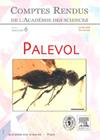上更新世16号洞穴大型非相似哺乳动物组合的taphonomique和空间研究(多尔多涅,法国)
IF 1.3
4区 地球科学
Q3 PALEONTOLOGY
引用次数: 1
摘要
对骨骼化石组合的研究提供了在更新世存在的动物群落的证据,而没有现代的类似物。这一点在旧石器时代的考古遗址中尤为明显,在相同的地层中,发现了在当今生态系统中很少有同域物种的遗骸。Grotte XVI(法国多尔多涅)的Mousterian - layer C -和ch本文章由计算机程序翻译,如有差异,请以英文原文为准。
Étude taphonomique et spatiale des associations de grands mammifères non analogues du Pléistocène supérieur de la Grotte XVI (Dordogne, France)
The study of fossil bone assemblages has brought up evidence of the existence in the Pleistocene of faunal communities with no modern analogues. This is notably the case for Palaeolithic archaeological sites that have yielded, in the same stratigraphic layers, remains of species that are rarely sympatric in present-day ecosystems. The Mousterian – layer C – and Châtelperronian – layer B – of Grotte XVI (Dordogne, France) provide examples of such “composite” faunas: high proportions of Red deer (21 % and 34 % of the total number of identifiable remains of ungulates, respectively), Roe deer (17 % and 14 %) and Reindeer (42 % and 26 %) have been described in the same assemblages. In order to better interpret these no-analog communities, large mammal remains from layers B and C of Grotte XVI are reanalysed here. Taxonomic identifications, taphonomic data (cortical surface states, anthropic marks, evidences of carnivore activity, etc.), season-of-death estimates and bone refits (intra- and inter-layers) are combined and analysed as part of a three-dimensional spatial study of the faunal assemblages.
求助全文
通过发布文献求助,成功后即可免费获取论文全文。
去求助
来源期刊

Comptes Rendus Palevol
地学-古生物学
CiteScore
2.10
自引率
0.00%
发文量
39
审稿时长
17.6 weeks
期刊介绍:
Comptes Rendus Palevol is a fully electronic and peer-reviewed journal, with a continuous publication stream, devoted to palaeontology, prehistory and evolutionary sciences. It publishes original research results, in French or English, in the following domains: systematic and human palaeontology, prehistory, evolutionary biology and macroevolution, and history of sciences. Thematic issues may also be published under the responsibility of a guest editor. All articles published in Comptes Rendus Palevol are compliant with the different nomenclatural codes. A copyright assignment will be signed by the authors before publication.
 求助内容:
求助内容: 应助结果提醒方式:
应助结果提醒方式:


